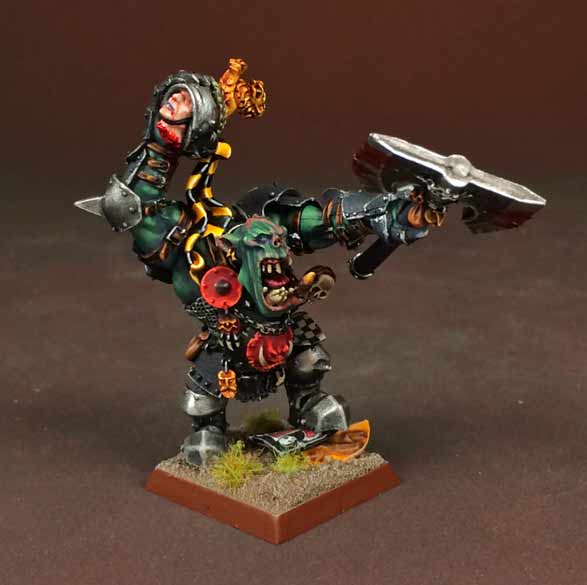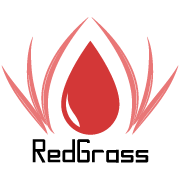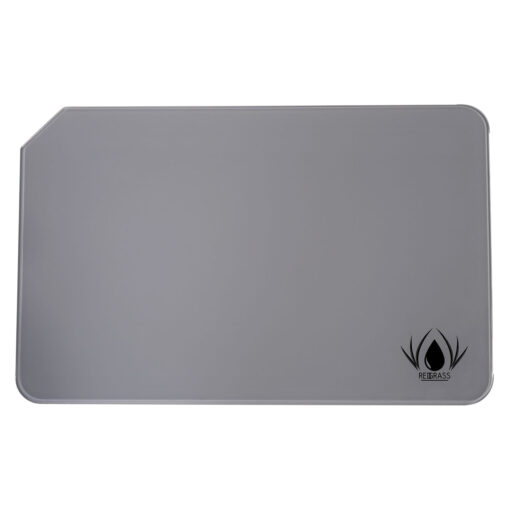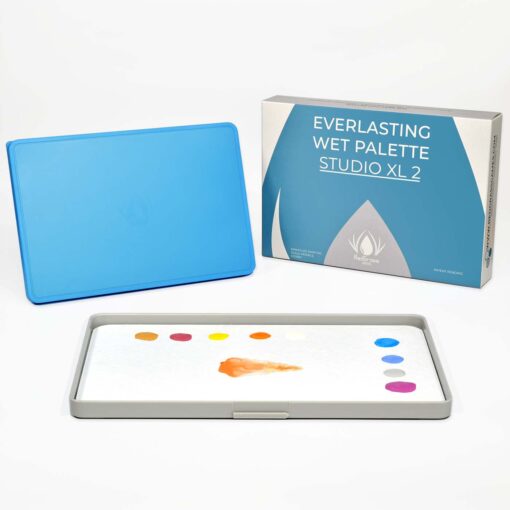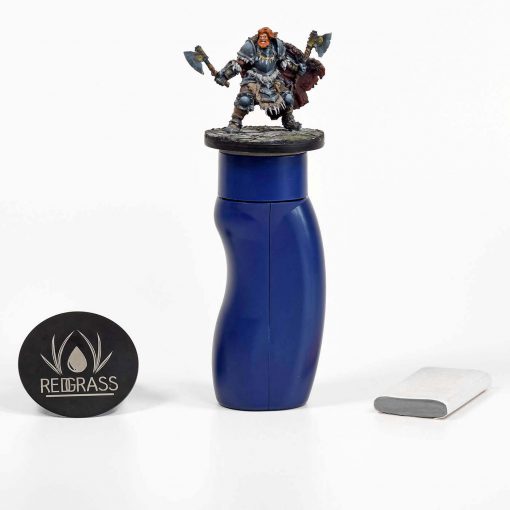Interview with Oscar Lars
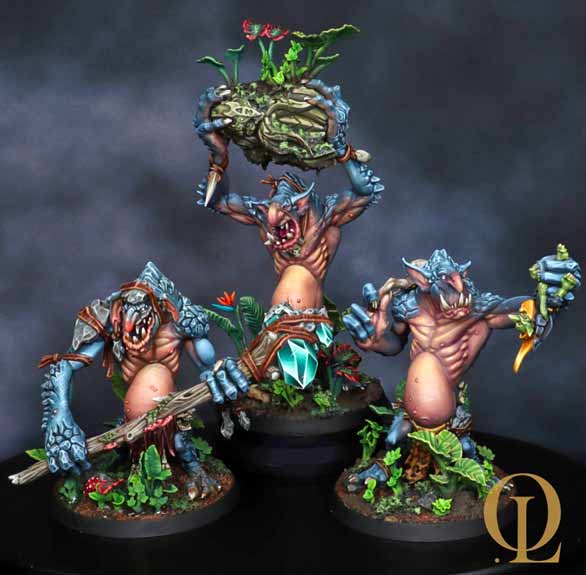
Pro-painter Oscar Lars is well-known for his wonderfully crisp paintjobs. As ‘@oscarlars‘ online, you can see his amazing warhammer paintjobs and commissions. He also has a website and Patreon page where you can learn! At Redgrass we love working with Oscar, so interviewing him for our readers is a real pleasure! Read on for insights for Oscar Lars!
Did you always know that you wanted to be a miniature painter?
I never knew I wanted to be a miniature painter for a living until I had already become one. When I first started the hobby, back in 1995, I didn’t even know it was a possibility. My first introduction to the hobby came at the age of five, when I was invited to a neighbor’s house to watch him play Warhammer Fantasy with his friends. They were much older than I, so the models were painted to a standard far beyond my skill set and the scenery was intricate, consisting of ruins, little huts, and woods. It all looked like the classic 80’s-90’s tables using insulation styrofoam, cardboard boxes, spackle, paint, and other household materials to create landscapes. All on green grass felt, of course. My first artistic endeavor with the hobby wasn’t painting models, but creating game boards for my future armies.
For my seventh birthday, my dad took me to the local game store in my hometown in Sweden. He let me pick out a set of paints, a brush, glue, and a box of Warhammer models (a box of very old Skaven Clan Rats). I believe this was the moment that began my true love of the hobby.
These experiences set the foundation for my drive within the hobby, which is to paint the models and play the game in a continuous cycle. Once I paint the models, I want to play the game, and once I play the game, I am eager to paint models. This is why I don’t typically paint models for display, but instead, focus on painting full armies to be used and enjoyed..
Today, I think my whole family would agree that the transition from hobby to job was a natural, inevitable one (though most of them are surprised it’s sustainable). I feel very lucky to have this opportunity, and to be able to work with all of my wonderful clients and supporters that help me continue to do what I love to do.
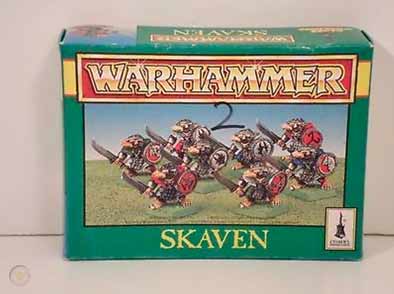
Where do you begin with a new miniature, is it more a technical or an instinctive choice?
I begin every model with a vision that is divided between the desire to paint it and field it on the tabletop. The next step I take is to construct the army as I envision the gamer playing it. For example, my Soulblight Gravelord army was heavily themed around wolves and the Vyrkos Dynasty. I did not want to go the classical route of wolves in a snow-powdered northern style landscape, but rather a southern desert. This would allow me to compliment the black wolves with a lighter sand covered base. Once my vision is fully established, I begin to paint the first model.
Translating my vision to the physical form of the model takes a combination of utilizing technical and instinctive choices. I think my instinctive choices come from years of experience practicing techniques and knowing what “works” and what doesn’t. One personal rule of thumb that I follow (with some exceptions) is to alternate the value ranges between different aspects of the models. Setting light colors up against darker colors, and warm tones against cold tones, etc. helps to separate those features.
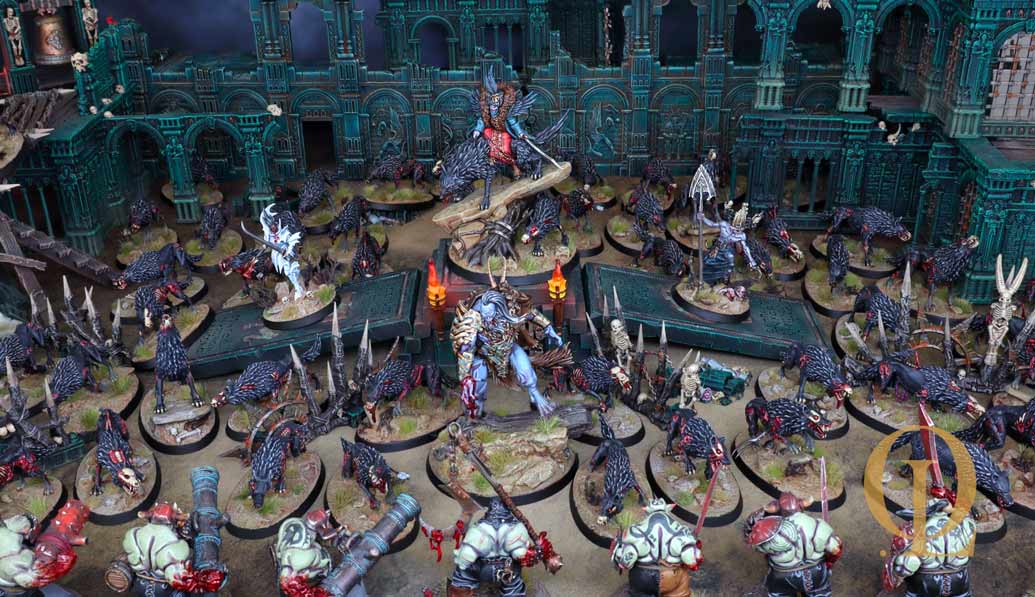
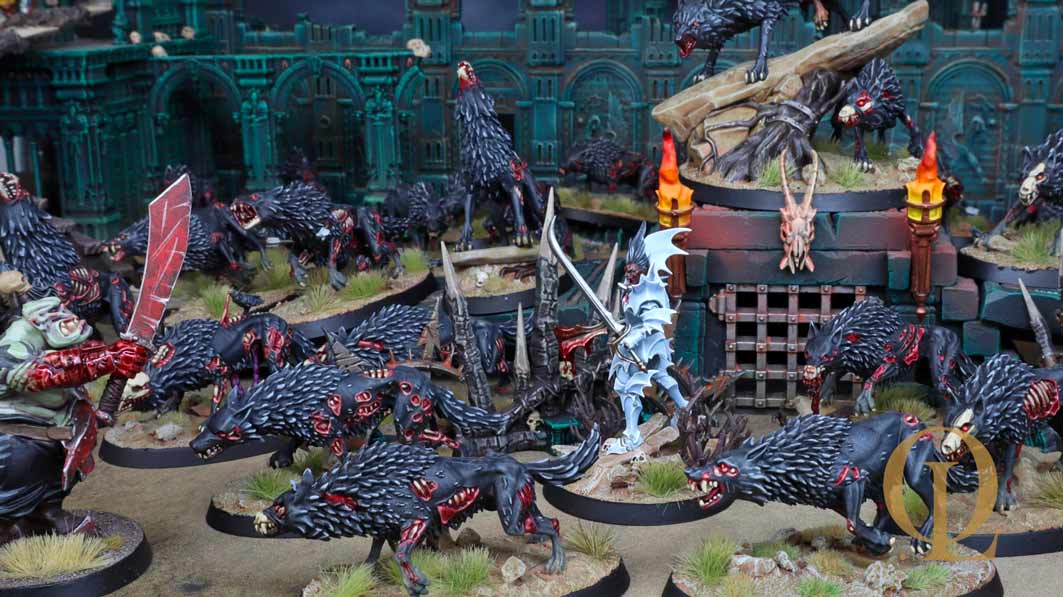
Which of your painted miniatures is your favorite or most meaningful to you?
I don’t have one specific model that stands out in a sentimental way, but I think my Nurgle army from 2019 would be the project I feel most proud of. I kept myself challenged in several ways throughout the duration of this project. I pushed myself out of my comfort zone with the paint job, sculpting, kitbashing, and conceptually staying the course of my vision.
The concept for this army was to create a Maggotkin of Nurgle army that would be visually appealing from a technical standpoint while still staying true to the gruesome and vile aesthetic of Nurgle. My biggest realization upon applying this concept, was that it takes an immense amount of work to keep the paint job consistent across the entire army considering that when you’re painting skin tone on a nurgle model, it isn’t enough to just paint the skin tone well. You have to blend the rotten flesh from the wound that is rotting back to the still fairly “healthy” skin. This means going through the colors that blend that in a natural way, blacks to blues, purples, pinks, greens and yellow before we are back to the common skin tone paints we use for caucasion skin tones.
The project also required a lot of research, which, in this case, I definitely do not recommend for painters with a weak stomach. I began the research by looking at paintings of severed limbs from historical artists such as Theodore Gericault, who painted a lot of isolated heads and appendages. But when this wasn’t enough to fully understand the color-complexity of decaying flesh, I ventured into the more medical side of the internet and essentially found what I was looking for. To make a long (and very gruesome) story short, I didn’t remain there for longer than I absolutely needed to. In the end, the research was incredibly helpful to gain a better understanding of the colors needed to create a more realistic disease and decay.
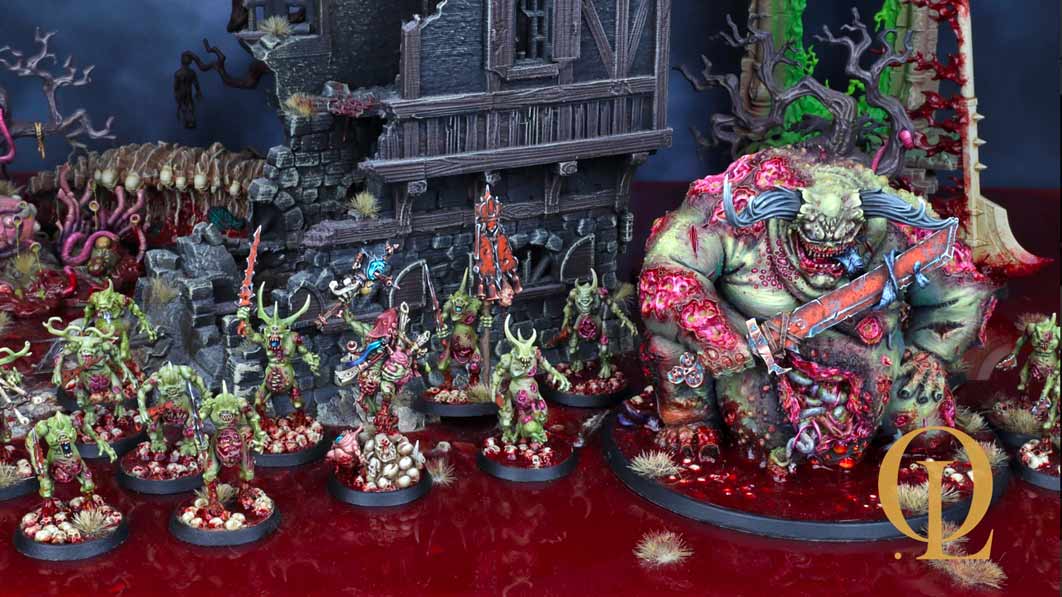
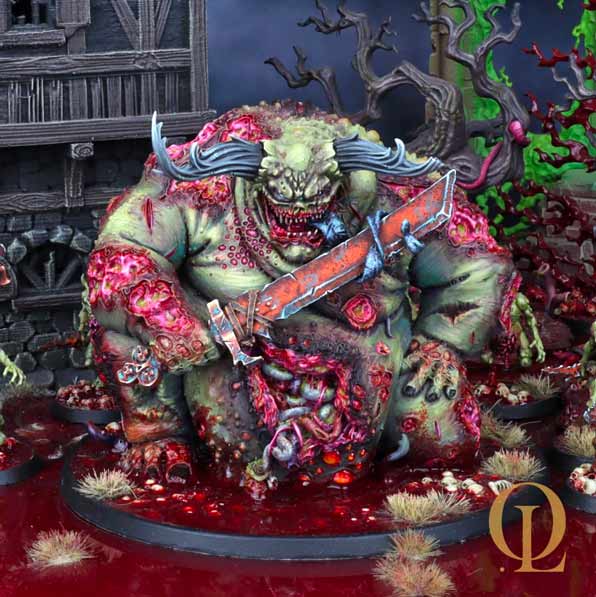
Is there a personal painting trick or hack you would like to explain to us?
One of the tricks I use when I block in paint (which is applying paint to every aspect of the model’s construction such as skin, hair, clothing, equipment, etc, before moving onto any other stage in the painting process) on a model is to slightly overlap the base colors.
This prevents the underpaint or primer from showing through. Starting with the first base color, you intentionally paint “outside the lines”, and with your next color, you can clean up those edges while simultaneously blocking in the next section. This is a very useful trick when painting units and armies for the tabletop.
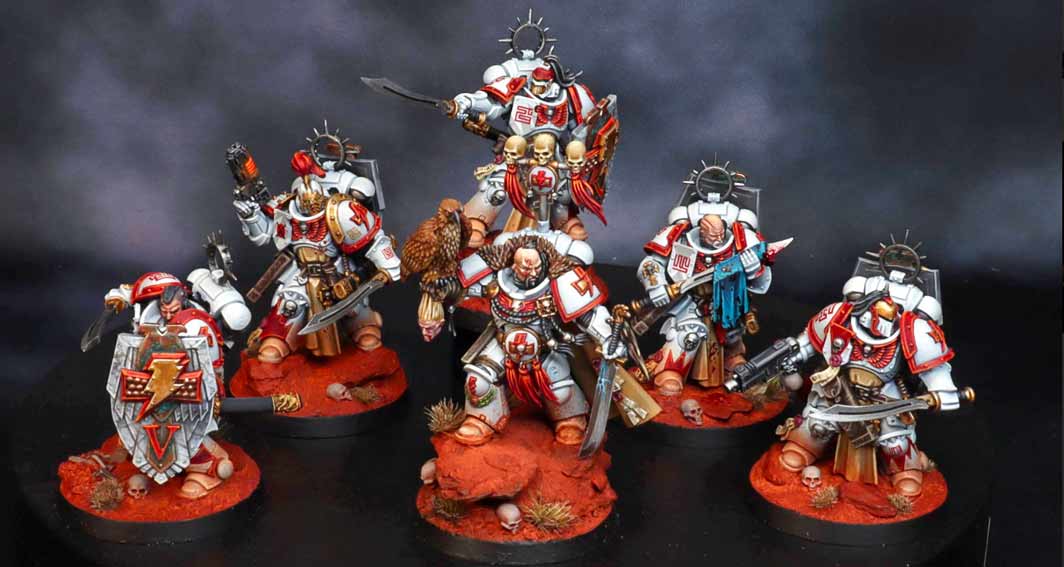
Do you have any other ‘creative’ hobbies you do? Do you feel they benefit one another in any way?
One of my passions outside of painting miniatures is to build gaming boards, display boards, and scenery. It allows me to work on a much larger scale without needing to be as precise and meticulous as I am when I work on miniatures.
One project that I was excited to work on involved creating a set of boards for a game called Wild West Exodus. It was a collaborative project with a very good (and very talented) friend of mine. We built several western style boards, each with a different environment including the outskirts of a Native American camp, a small town, a mining camp, and an abandoned old union fort.
For some of my clients, I create simple display boards to go with their commissioned army so that they have something to showcase at tournaments, or in their homes or gaming space. I use a wide variety of materials like sculpting paste, concrete patch, plaster, sand, and rocks before I paint and apply the toppings to match the bases. It’s a fun exercise to round off the project and it allows me to take some nice pictures at the end.
I also build all the scenery for the local monthly tournaments I co-host with Warpcharged Gaming at Battlegrounds in Richmond, VA. This scenery is designed to be mass produced, easy to play on, themed, and still look nice for a fully immersive experience. Sometimes, I’ll even build scenery for myself when passion really hits me. Right now, I am at the early stages of creating a junglescape to go with my Gloomspite Gitz and my upcoming Kharadron Overlords armies. It will be the most elaborate scenery kit I’ve made so far.
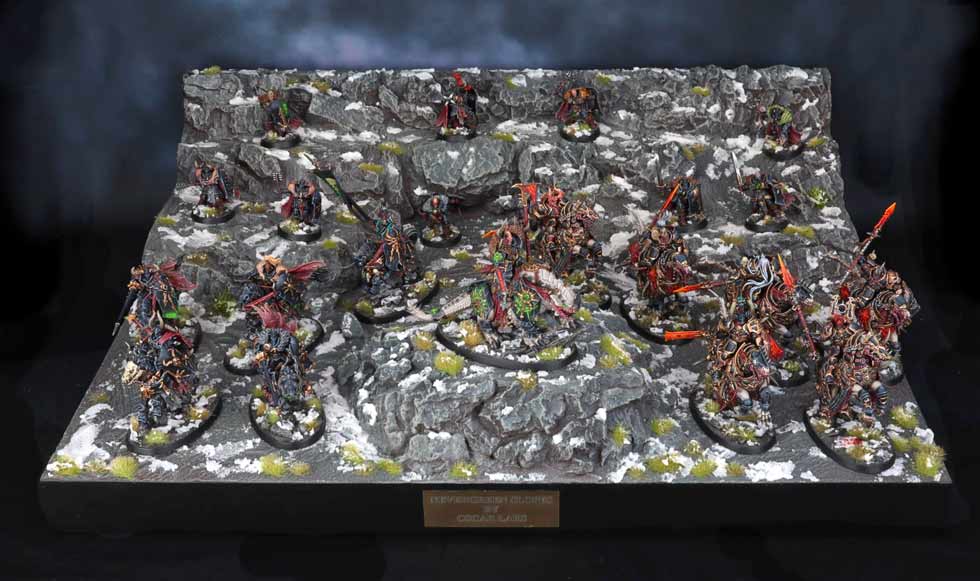
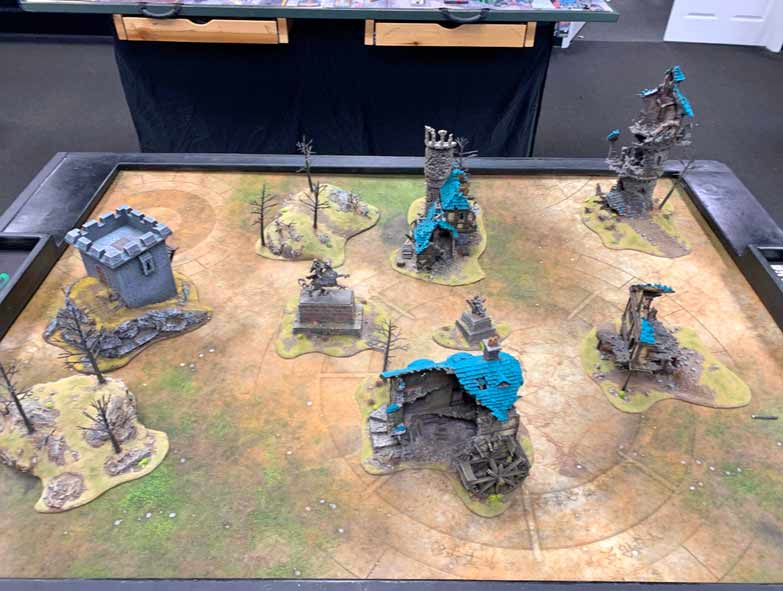
What are the most important techniques you think a miniature painter should know?
I’d say that having a general understanding of blending, dry-brushing, and glazing techniques would be great tools for a model painter to keep in their arsenal. In addition, I believe the layering technique to be the most valuable one you can learn. It’s the most basic “get-paint-on-your-model” kind of technique, and can be used to create anything. I also think it helps the colors to achieve their greatest potential, as each previous layer acts as a support for the following pigments to sit on. Which, in the end, makes things look really pretty. Now I use glazing and wet-blending (layering two paints next to each other and then blending them into one another), but you can’t properly wet-blend if you can’t properly layer. This is why in every class I teach at my studio, the first thing covered is how to properly layer paints.
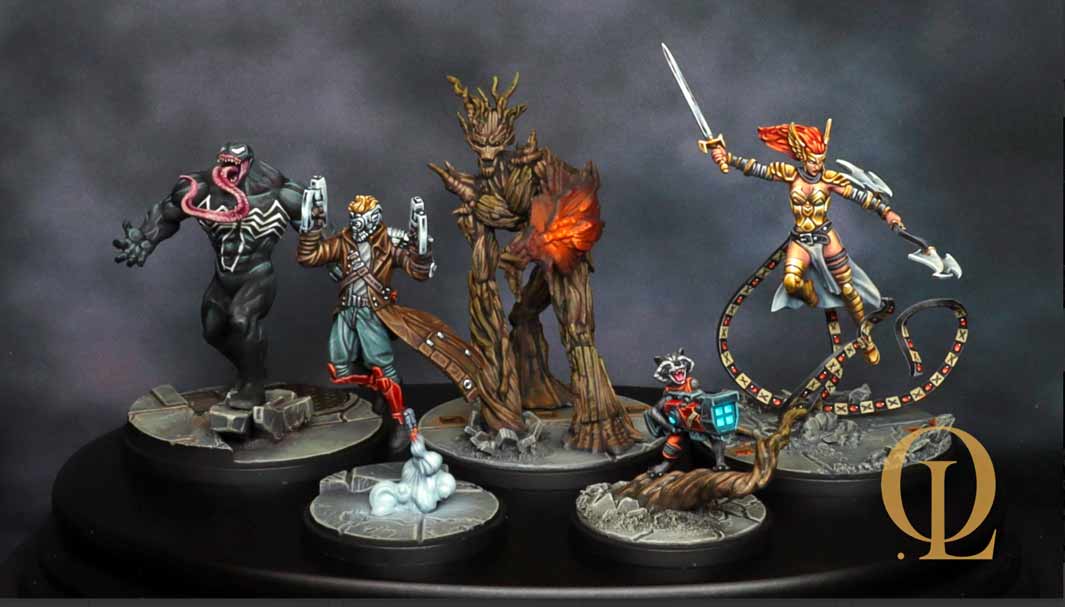
Do you use any non-acrylic painting techniques in your work?
I dabble with enamel, pigments, and oils, but I don’t use them very often. It is really for no other reason than they simply don’t speak to me in the same way that acrylics do, and I have more fun using acrylics. I frequently use streaking grime when I build larger scenery projects as it helps to speed things up. I do like working with resins, like UV resins to complement the acrylic paintjobs to create movement and extra fun details, such as the blood on this Drycha.
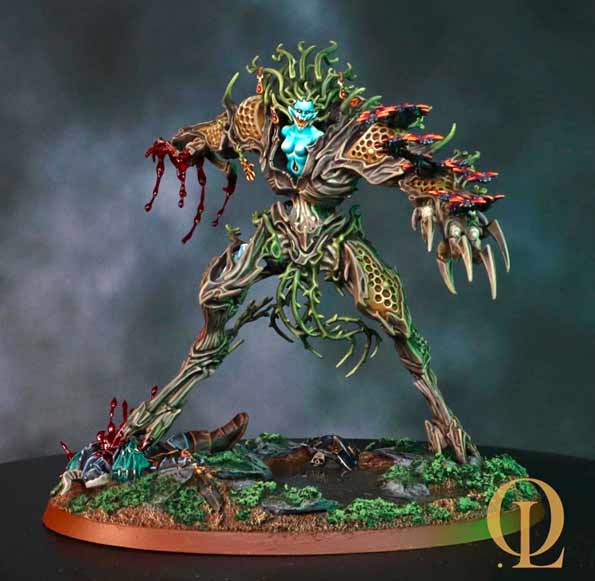
8. What is the number one question you get asked a lot?
My most frequently asked question is, “How do you create your color palettes for all of the different army projects you paint?”. The answer probably isn’t very satisfying because it’s a long list of experiences that have gotten me to this point in my career. To start, I have over 20 years of experience painting miniatures and armies, dating back into the 90’s. I have made a lot of not-so-great choices throughout those years and learned from them. I kept painting at the level I was at, both technically and conceptually and kept aspiring to become better at both.
But I never stressed about being better than I was at the time. Just analyzing what I could change or do better on the next project. Commission painting definitely helped to propel the amount of work I produced in a given year, and getting feedback from clients was a helpful tool to gauge what preferences other people have.
I’ve also earned a five-year degree in Fine Arts where I focused a lot of attention on color theory. Having that experience has helped push my color concepts forward at a rapid pace by testing the boundaries and assessing a fuller understanding of how color truly functions when combined.
The best advice I can give to someone who wants to become better at selecting successful color schemes is to take classes, paint a lot, paint some more, and allow time to work its magic through your labor. Don’t give up and don’t feel the pressure to trade the fun of the hobby for the stresses of getting better too fast.

Is there a model you have already painted you would love to paint again?
I painted the old metal Grimgor Ironhide from Warhammer Fantasy probably about 7 or 8 years ago. I recently came across (and purchased) this model on Ebay, and have it in the books to paint up for the Tablewar Autism Charity auction. It’ll be super fun to compare the two models once I’m done.
I will probably do everything differently except for layering the paint. This will be one of the few times I paint a model for display rather than play. So pushing my limits is the goal here, which it wasn’t all those years ago.
